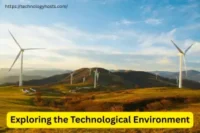What is Renewable Technology? A Beginner’s Guide to Clean
Published: 02 Feb 2025
In a world facing climate change and energy crises, renewable technology is leading the way toward a sustainable future. But what exactly is renewable technology, and how does it work? Simply put, it refers to clean energy solutions that harness power from natural sources like the sun, wind, water, and earth’s heat.
Unlike fossil fuels, these technologies are eco-friendly, cost-effective, and unlimited. In this guide, we’ll explore how renewable technology works, its benefits, the latest innovations, and how it’s changing industries worldwide. Ready to discover the future of clean energy? Let’s dive in.

1️⃣ What is Renewable Technology?
Renewable technology is a type of energy production system that uses naturally replenishing sources like:
✅ Solar Energy → Converts sunlight into electricity.
✅ Wind Power → Uses turbines to generate energy from wind.
✅ Hydropower → Harnesses flowing water to produce electricity.
✅ Geothermal Energy → Uses the earth’s heat for power and heating.
✅ Bioenergy → Converts organic materials (plants, waste) into fuel.
Unlike traditional fossil fuels (coal, oil, gas), these renewable energy sources do not deplete and have a much smaller impact on the environment. what is information technology
How Does Renewable Technology Work
Renewable technology operates by capturing, converting, and distributing energy from naturally replenishing sources like the sun, wind, water, and Earth’s heat. Unlike fossil fuels, these methods generate clean, sustainable power without depleting resources. Here’s how the process unfolds.
Converting Energy into Electricity or Heat
Each renewable system has a method of transforming captured energy into usable power:
- Solar panels use photovoltaic cells to convert sunlight into electricity.
- Wind turbines rotate generators that produce electrical power.
- Hydropower dams direct water flow through turbines to generate electricity.
- Geothermal heat produces steam to spin turbines and generate power.
- Biomass undergoes processing to create biofuels or biogas for energy production.
Storing and Distributing the Energy
Because renewable energy sources like solar and wind are intermittent, advanced storage and distribution systems are essential. Some of the key solutions include:
Battery storage systems (such as lithium-ion or solid-state batteries) store excess power for later use.
Hydrogen fuel cells allow energy to be stored and converted when needed.
Smart grids manage energy demand and optimize power distribution.
Pumped hydro storage moves water to a higher reservoir when energy is abundant and releases it to generate power when needed.
Why is Renewable Technology Important?
These technologies play a crucial role in reducing carbon emissions, promoting energy security, and supporting the transition to a low-carbon economy. By utilizing resources that are naturally replenished, renewable technology ensures that energy production can continue without depleting natural reserves. As these technologies advance, they promise to provide even more efficient, affordable, and scalable solutions to meet the growing demand for clean energy worldwide.
Key Types of Renewable Technology
Solar Power
Solar energy is one of the most widely used renewable technologies. Photovoltaic (PV) panels convert sunlight into electricity, while solar thermal systems use sunlight to generate heat for water or air conditioning systems. Advances in solar panel efficiency and affordability have made this technology increasingly accessible for residential and commercial use.
Wind Energy
Wind turbines generate power by harnessing the kinetic energy of moving air. This technology is highly effective in coastal and open-land areas where wind speeds are consistent. Offshore wind farms are becoming increasingly popular as they offer stronger and more reliable winds. How Information Technology is Revolutionizing Education
Hydropower
Hydropower, or hydroelectric power, uses the movement of water to generate electricity. Large dams control water flow through turbines, producing a stable and predictable power supply. Small-scale hydropower solutions are also emerging, allowing local communities to generate electricity from rivers and streams.
Geothermal Energy
Geothermal technology uses heat from beneath the Earth’s surface to produce power or provide direct heating. This energy source is highly reliable and has a minimal environmental footprint. It is commonly used in areas with high geothermal activity, such as Iceland and parts of the United States.
Bioenergy
Bioenergy involves converting organic materials into usable fuels. Biomass, such as wood, agricultural waste, and algae, can be burned or processed into biofuels like ethanol and biodiesel. Biogas, produced through anaerobic digestion, is another sustainable energy source used for heating and electricity generation.
Environmental & Economic Impact
Renewable technology not only transforms the way we produce energy, but it also offers a range of environmental and economic benefits that are reshaping industries and societies worldwide.
Environmental Benefits:
Reduction in Carbon Emissions:
Unlike fossil fuels, renewable energy sources emit little to no greenhouse gases. By transitioning to renewables, we significantly reduce our carbon footprint, helping to mitigate climate change and air pollution.
Conservation of Resources:
Renewable resources like wind, sunlight, and water are infinite. Unlike coal, oil, and gas, they don’t deplete over time, which makes them an ideal solution for sustainable long-term energy production.
Preservation of Biodiversity:
Renewable energy generation, particularly from solar and wind, has far fewer harmful effects on wildlife compared to fossil fuel extraction, such as mining or drilling, which can lead to habitat destruction and biodiversity loss.
Cleaner Air and Water:
Power plants that burn fossil fuels contribute to poor air quality and water contamination through harmful emissions and waste. Renewable energy technologies produce little to no pollution, contributing to healthier air, water, and soil.
Latest Innovations in Renewable Technology
🚀 1. Floating Solar Farms → Solar panels installed on water.
🚀 2. AI-Powered Smart Grids → Optimizes energy use in real-time.
🚀 3. Hydrogen Fuel Cells → A clean alternative for transport & storage.
🚀 4. Space-Based Solar Power → Satellites collect solar energy from space.
🚀 5. Ultra-Efficient Batteries → New lithium-ion and solid-state batteries.
🌍 Future Trend: The rise of AI-driven renewable energy for smarter, more efficient power management.
Challenges of Renewable Technology
🔴 Problem: High initial costs 🚧
✅ Solution: Government incentives & falling technology prices.
🔴 Problem: Weather dependence (Solar & Wind) 🌦️
✅ Solution: Energy storage solutions like batteries & hydrogen.
🔴 Problem: Large land requirements 🏞️
✅ Solution: Offshore wind farms & floating solar panels.
🔴 Problem: Limited infrastructure 🔋
✅ Solution: Expansion of smart grids & renewable networks.
🚀 Pro Tip:
Combining multiple renewable sources makes energy more reliable!
Future of Renewable Technology: What’s Next?
🌎 1. AI & Machine Learning in Renewable Energy
🤖 Smart grids, automated energy management, and predictive maintenance.
🚗 2. Renewable-Powered Electric Vehicles (EVs)
🔋 Solar and wind-powered EV charging stations.
🏠 3. Net-Zero Smart Homes & Buildings
🌞 100% solar-powered homes with energy-efficient technology.
🛰️ 4. Space-Based Solar Power (SBSP)
🚀 NASA is testing satellites that beam solar energy from space to Earth!
🌍 The renewable energy industry is expected to grow 10x by 2050!
conclusion
Renewable technology is transforming how we generate, store, and use energy. With innovations in solar, wind, and hydrogen power, the world is moving toward a clean, sustainable future. From reducing carbon emissions to saving money on electricity, the benefits are undeniable.
Whether you’re looking to install solar panels at home, invest in electric vehicles, or simply learn about the future of clean energy, renewable technology offers endless opportunities.
🌱 The future is green, and it starts with renewable energy!
✅ Want to switch to renewable energy? Start today
1️⃣ What is the main goal of renewable technology?
A) To increase fossil fuel usage
B) To generate energy from naturally replenishing sources
C) To make electricity more expensive
D) To eliminate the need for energy storage
2️⃣ Which of the following is NOT a type of renewable energy?
A) Solar power
B) Wind energy
C) Nuclear power
D) Geothermal energy
3️⃣ How do wind turbines generate electricity?
A) By converting wind into heat energy
B) By using wind to spin a generator that produces electricity
C) By absorbing sunlight and storing it in batteries
D) By using underground heat sources
4️⃣ What is a major benefit of renewable energy?
A) It produces unlimited pollution
B) It reduces greenhouse gas emissions
C) It depends entirely on fossil fuels
D) It is always available, 24/7, without storage needs
5️⃣ Which technology helps store renewable energy for later use?
A) Gasoline engines
B) Hydrogen fuel cells and batteries
C) Coal power plants
D) Nuclear reactors
📌 Answers: 1️⃣ B | 2️⃣ C | 3️⃣ B | 4️⃣ B | 5️⃣ B
Renewable technology faces challenges such as high initial costs, energy storage limitations, and dependency on weather conditions (for solar and wind). However, advancements in battery storage, smart grids, and hybrid energy systems are helping to overcome these obstacles.
While renewable energy has the potential to replace fossil fuels in the future, the transition requires better storage solutions, infrastructure upgrades, and large-scale adoption. Many countries are already moving towards 100% renewable energy, but a complete shift will take time and continued investment in clean energy technologies.
Proudly powered by WordPress






